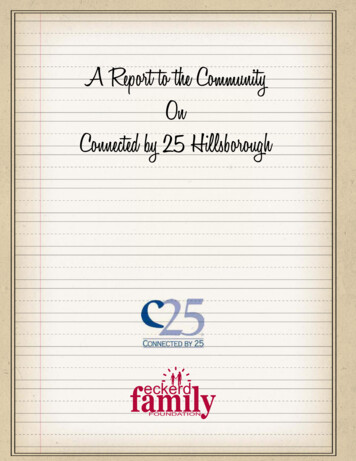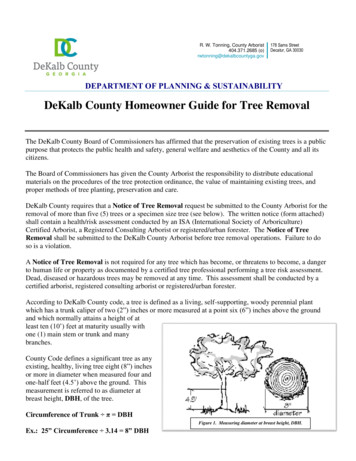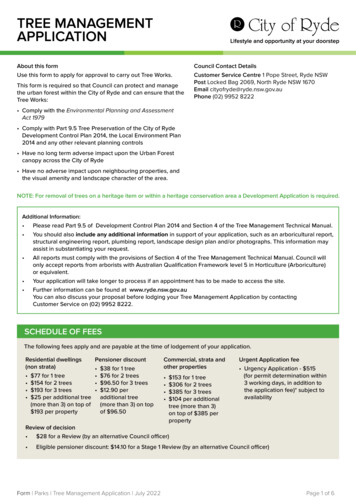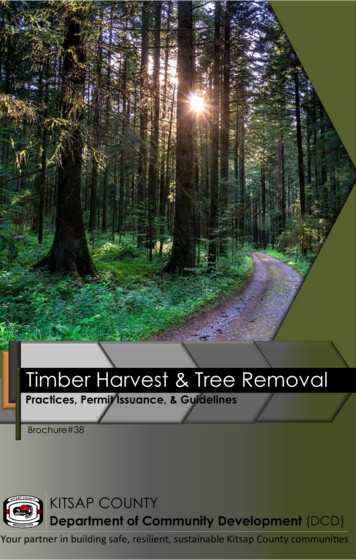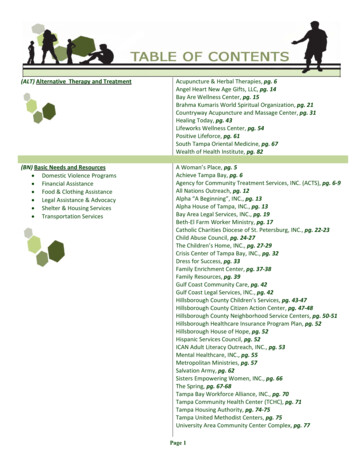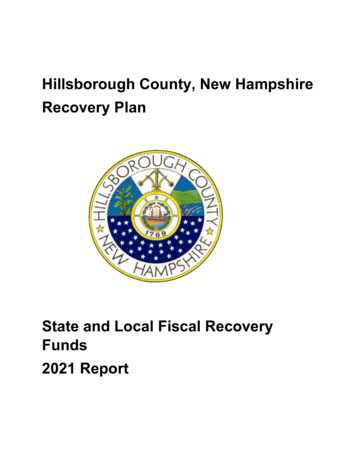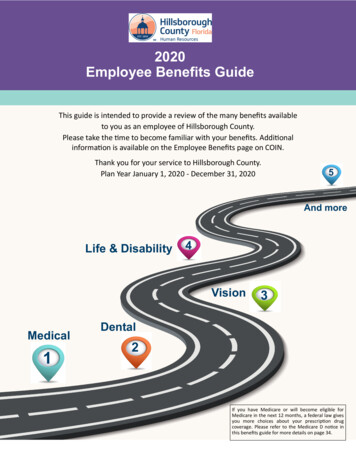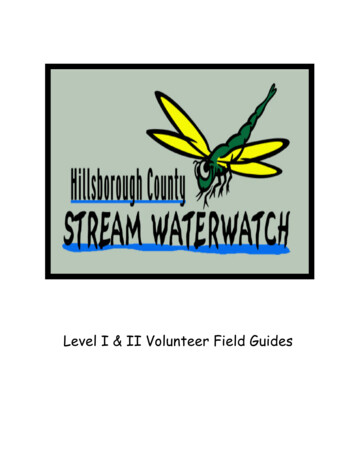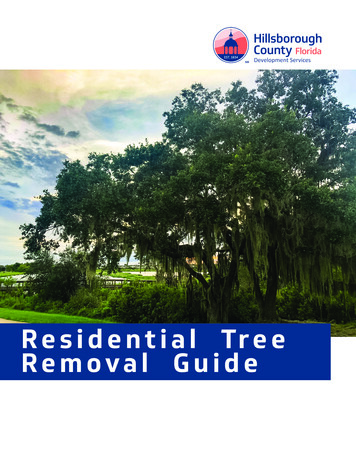
Transcription
R e s i d e n t i a l Tr e eRemoval Guide
Do I need a permit to remove my tree?It may seem as though there are as many rules for removing trees as there aredifferent species of trees. We’re here to help! This document will provide youwith general guidelines to help determine whether a permit is needed for yourtree removal project. Use this guide to determine if a permit is required priorto removing your tree.STEP 1: Determine the tree’s location for the purposeof a tree removal permitFor the purpose of permitting requirements, use the graphic below to determinethe location of the tree you wish to remove. You will use this location in conjunctionwith the size of the tree to determine if a permit is required.Loca on of Tree To Be Removed1: RequiredStreetROW Tree Loca onLoca onof TreeToTreeBeorRemoved1:2:3:4:2: Front,StreetSide &TreeBackorYardTreeLoca onRequiredROWTreeLoca on3: WetlandTreeLoca onFront,Side &SetbackBack YardTreeLoca on4: Wetlandor Conserva onWetlandSetbackTree Loca onArea TreeLoca onWetlandor Conserva onArea Tree Loca on423234221221STEP 2: Measure the tree’s diameterFind the tree’s Diameter at Breast Height (DBH) and use the chart on the followingpage to determine if the tree requires a permit for removal due to its size andlocation. To determine the DBH of your tree, measure all the way around the tree(as if you were measuring your waist) approximately 4.5 feet from the ground anddivide by 3.14. For example: a 40” circumference tree is going to have a DBH of justunder 13 inches.2 of 6
Do I need a permit to remove my tree?Using the size and location of your tree, check the chart below to determine if apermit is required prior to removal. If you still require assistance or clarification,please reach out to our Natural Resources staff at (813) 627-1300.Type of Residence1Tree locationYard, Lot,2 nAreaSingle Family(not in a subdivision)5” DBH andLarger12” DBH andLarger12” DBH andLargerContact EPCSingle Family(in a subdivision/PD)Any Size112” DBH andLarger12” DBH andLargerContact EPCMobile Home(own the land)5” DBH andLarger12” DBH andLarger12” DBH andLargerContact EPCMobile Home(rent the lot, in a park)Any Size15” DBH andLargerAny SizeContact EPCCondominium(common areas)Any Size15” DBH andLargerAny SizeContact EPCTownhomes(on your land)Any Size112” DBH andLarger12” DBH andLargerContact EPCTownhomes(common areas)Any Size15” DBH andLargerAny SizeContact EPCDuplex, garden homeor patio homesAny Size112” DBH andLarger12” DBH andLargerContact EPCVacant Residential Lot(not in a subdivision)(ROW) 12” DBHor Larger5” DBH andLarger5” DBH andLargerContact EPCNotes:1. Required street trees must be replaced with a tree from the approved street tree list. If you areplanting palms to replace other trees, you must plant 2 palms for every tree removed.2. When trees are located within 100 feet of the Hillsborough River, Palm River, Little Manatee River orAlafia River, removal may be prohibited per Hillsborough County Land Development Code 04.01.06.Other Considerationsn For Right of Way (ROW) trees, a separate permit may be required by the ROW use team forwork conducted in this area if the right of way is County maintained.n Even if a tree does not need a permit to be removed, you may have to plant a tree to ensureyour lot meets the minimum number of lot/shade trees required. Hillsborough County LandDevelopment Code Section 06.06.03B specifies the minimum number of required lot/shadetrees.n Certain trees are exempt and will not require a permit for removal, regardless of size.n Grand Oaks are governed by more stringent requirements.3 of 6
Frequently Asked QuestionsnDo I need a permit from Hillsborough County?These guidelines for tree removal permits are only for properties in “Unincorporated”Hillsborough County. Properties in the jurisdiction of the City of Tampa, Temple Terrace,or Plant City, would need to apply for tree removal through those municipalities. Visitthe Hillsborough County Property Appraiser’s office to find out if your property is inunincorporated Hillsborough County.nDo I need a permit to remove a dangerous tree (House Bill 1159)?Yes, the standard rules for tree removal apply to dangerous trees. However, legislation was passed in 2019that eliminates the requirement for a homeowner to obtain a permit from a local municipality if an ISACertified Arborist or Licensed Landscape Architect can provide documentation that the tree is dangerousaccording to current arboricultural standards.The County asks that if you do have your tree(s) declared/documented as dangerous, by an ISA CertifiedArborist or Licensed Landscape Architect, you or the arborist/landscape architect send that documentationor report to the County as an official record of that declaration.The county’s “Dangerous Tree Declaration” should be emailed to Natural Resources staff atnaturalresources@HCFLGov.net. There is no fee to submit this to the county.nHow do I find an ISA Certified Arborist?You can search for an ISA Certified Arborist by name or location by visiting www.treesaregood.org.nDo I need a permit to remove a dead tree?A totally dead tree with no green leaves (zero living tissue) or life in it will not require a permit as long asthe tree is not located in an environmentally sensitive area, such as a wetland, wetland setback or wetlandconservation area. Remember, during certain seasons some species of trees can drop their leaves untilspring. That tree is not dead. Consult with an ISA Certified Arborist to evaluate your tree. Always takepictures of the dead tree before removal and be sure to save those pictures.Totally dead trees (zero living tissue) may not require a permit, however, the removed tree may requirereplacement. Please contact our staff or consult with an ISA Certified Arborist.nWhat is required for a tree removal application to be approved?The tree must have health issues or be causing damage that cannot be otherwise resolved without removingthe tree. Sidewalk/driveway damage can many times be resolved by root pruning. A certified arborist cando root pruning and determine if that will resolve the cause of the damage.nDo I need a permit to trim, cut, or prune my trees?No, however, there is a limit to the amount of pruning you can do to a tree in a growing season.25% of the trees canopy is the maximum recommended. Excessive pruning may result in corrective orenforcement actions. Consultation with an ISA Certified Arborist is recommended before you begin work.To prune a Grand Oak, you must submit a Grand Oak Pruning Affidavit filled out by a Certified Arborist, priorto performing the pruning. It can be emailed to Natural Resources staff at naturalresources@HCFLGov.net.The Certified arborist must be on site during the pruning of the Grand Oak.4 of 6
Frequently Asked QuestionsnWhat is a Grand Oak?In unincorporated Hillsborough County, it’s any oak tree (genus Quercus) that isevaluated by an ISA Certified Arborist that meets the following criteria: Minimum of 34” diameter at 4.5 feet up from the ground Symmetrical canopy spread that meets 175 points or greater Is in good or better conditionnHow do I know if my oak is a grand oak?An ISA certified arborist has an ISA required check list and process to determine if an oak is grand.Hillsborough County’s Grand Oak Regulations provide a useful guide.nCan I prune/cut/trim the part(s) that hangs over my property line?Yes, but you cannot cut the tree in half or improperly cut/prune/trim. Improper pruning/trimming/cuttingare detrimental to the tree. You have every right to prune branches that extend or hang over your propertyline, however, you must follow good, established pruning practices while doing so. Over-pruning or sidecutting a tree could result in enforcement activities and/or mitigation - not to mention potential civil issuesbetween you and your neighbor.Always consult with an ISA Certified Arborist before pruning a boundary line or property line tree.nWhat happens if I don’t get a permit from the County, and I remove/cut down my tree anyway?If the tree removal is reported to the County and investigated, and you did not get a permit nor do youhave a letter declaring the tree dangerous (by an ISA Certified Arborist or licensed Landscape Architect), yourun the risk of facing corrective enforcement which can include monetary penalties and/or mitigation.Penalties include paying 65.00* per diameter inch for the tree that was removed and/or replanting(mitigation) of an equivalent amount of DBH inches in trees. For example, removing a 20” DBH tree withouta permit will result in a fine of 1,300.00.*All fees are subject to change.nHow do I apply?Apply for a Tree Removal Permit through the HillsGovHub portal.nHow long does it take?Generally it takes approximately 3-4 weeks from the time we receive the application. We send out anarborist to review the trees on site. To receive it faster, usually within 5 days, you can have a certifiedarborist evaluate the tree and fill out the arborist sections of the tree removal permit application. A certifiedarborist is not required to apply for the permit.nCan I get my own permit to remove my tree(s) or do I need a certified arborist to apply for thetree removal permit?Homeowners may apply for their own tree removal permit. You do not need a certified arborist to apply butyou do have that option. That is why that form is provided. Using a Certified Arborist is completely optional.If you use an ISA Certified Arborist to complete the application, and he/she feels the tree meets the criteriaof the code, the arborist may complete that form which will relieve staff of having to come to your home toinspect the tree, which allows us to issue the permit to you usually within 5 days.5 of 6
Frequently Asked Questionsn What if I am not comfortable pulling my own permit and/or filling out paperwork?What can I do?You may have your tree service contractor or certified arborist apply for the permit onyour behalf. Tree services regularly do this for their clients and are likely familiar with theprocess.nHow can I check the status of my permit or get a copy of the permit?Log in to your HillsGovHub account to check your permit status. HillsGovHub provides regular updatesvia email. The contact on your application will receive a copy of the permit via email once it is approved.Please check your SPAM or JUNK folder.nMy permit was denied. What are my options?You can appeal within 30 days to staff. Your appeal can include things like repair bills, photos of damagewe could not see, engineering reports, and any other pertinent information relative to the denial of thepermit. If staff upholds the decision to deny the removal, you can request that your appeal be heard bythe Land Use Hearing Officer (LUHO). Going to a LUHO hearing has added fees, currently 2245.82, inaddition to that of your tree removal application. Please remember, fees are subject to change.nWhere can I get answers to questions I don’t see listed here?Please email your question to our staff at naturalresources@HCFLGov.net.Disclaimer: The information listed in this guide applies to the most common situations encountered during a tree removal project. There may be specificsituations not covered in this guide. The information contained here does not supersede regulations established in the Hillsborough County Land DevelopmentCode. If you suspect your situation may fall outside of the parameters listed in this guide, please consult with our Natural Resources team.6 of 6
Find the tree's Diameter at Breast Height (DBH) and use the chart on the following page to determine if the tree requires a permit for removal due to its size and location. To determine the DBH of your tree, measure all the way around the tree (as if you were measuring your waist) approximately 4.5 feet from the ground and divide by 3.14.
